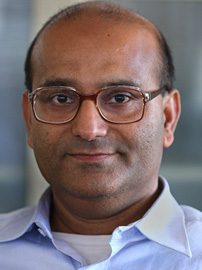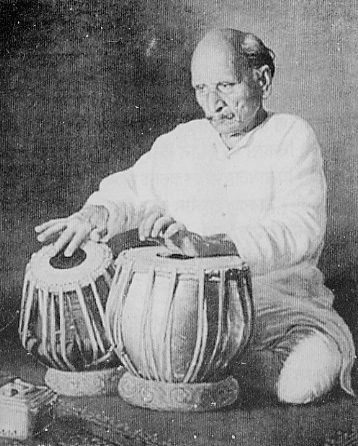by Rajan P. Parrikar
First published on SAWF on June 12, 2000

Rajan P. Parrikar
Namashkar.
In this feature two variants (prakars) of Raga Bihag, namely, Bihagda and Pat Bihag, are addressed. I expect to keep the commentary terse and precise. At the end of this article, an unpublished 1964 Pune mehfil of the great tabla maestro Ahmad Jan ‘Thirakhwa’ is offered.
Throughout the discussion, M = shuddha madhyam and m = teevra madhyam.
Raga Bihagda
The key idea in this raga is the introduction of the komal nishad into the Bihag dynamic. This is accomplished chiefly through two tonal sentences of the type:
G M n D P, G M G
G M P D n D P, G M G
Raga Bihagda may thus be seen as an offshoot of Bihag with strands of Khamaj spliced in. Although the influence of Bihag preponderates, a few special prayogas carve out an independent identity for Bihagda. To wit:
S G, GMPMP G (R)S
S G M D, D P, GMPMP G, D M P N, N S”
As in Bihag, the gandhar is very strong (nyasa swara) and so is the nishad. The measured avarohi glide from G to S grazing R en route is inspired by Bihag. So is the movement from N to P. The teevra madhyam is eliminated or rendered weak (alpatva) in almost all treatments. With this brief and essential background we now march into the audio theatre where we have opportunities aplenty to isolate and examine the raga lakshanas..
In the mid-1960s Jitendra Abhisheki composed an enchanting Marathi natyageeta based in Bihagda for YAYATI-DEVAYANI and then callously handed it over to amcho Ramdas Kamat to molest. Ramdas-bab’s tans remind us of the first bawling of a freshly-baked baby struggling to cope with life outside the amnion. I have masterfully edited the clip to spare you the trauma: mee maanapamaanaa.
The same Abhisheki-Kamat combine once again, this time from the musical HE BANDHA RESHAMACHE (1968). This natyageeta draws on lakshanas of Bihagda, Savani, and PatBihag: sangeeta rasa surasa mama jeevanadhara.
Bade Ghulam Ali Khan‘s selection from an unpublished mehfil retains a strong Bihag presence, including graces of the teevra madhyam.
A variety of tonal formulations and uccharana is observed in the clusters laden with komal nishad. For instance, Shaila Datar sings a composition of the late Master Krishnarao that is sparing in its use of the komal nishad.
The gifted musician and composer of the Khurja Gharana, Zahoor Khan, is not a familiar name to the current generation of rasikas. He was a polyglot comfortable in Sanskrit, Braja, Farsi and Urdu. Trained by Tanras Khan, he adopted the mudra ‘Ramdas’ for his Braja poetry and ‘Mumkin’ for his Urdu takhallus.
Prabhudev Sardar presents a beautiful khayal composed by ‘Ramdas’: maa’i ri.
The popular bandish composed by Jagannathbuwa Purohit ‘Gunidas’ in honour of the his guru Vilayat Hussain Khan is presented here by Gunidas’s pupil Prabhudev Sardar: sakhi mandarwa, aaye nahin preetam pyare.
The Atrauli-Jaipur musicians have reified Bihagda into their gharana’s emblem almost, elevating it to heights unscaled before their time. We have lined up a battery of the leading lights of that school.
Who better to begin with than Alladiya Khan‘s prized pupil Kesarbai Kerkar? The first half of the clip finds her in a leisurely gait, before unleashing a cannonade of impressive tans. Take stock of the interplay of the two nishads. The composition is Alladiya Khansahib’s favourite: pyari paga hole.
The next two items figure Alladiya Khan’s other star pupil, Mogubai Kurdikar, in an unforgettable display. Your attention is drawn to the explicitly intoned teevra madhyam in this rendition. This is not an across-the-board feature of the Atrauli-Jaipur conception of Bihagda. The phraseology supporting teevra madhyam advanced by Mogubai creates an avirbhava of Raga Nand. The first clip below elaborates on pyare paga hole, the second is the well-known cheez, mohe jane de.
Sardarbai Karadgekar, a disciple of Nathhan Khan (Alladiya Khansaheb’s nephew), has her say.
Mallikarjun Mansur reprises the standard Atrauli-Jaipur bandish but with a tweak attributed to his guru Manji Khan (son of Alladiya Khansaheb): the placement of the sam on the pancham.
Tha Jaipur-Atrauli musicians also sing a variation of Bihagda, called the “Ek Ni Bihagda,” where, as the name suggests, only one nishad – shuddha – is employed. The elongated (i.e. deergha) dhaivat and its interplay with the shuddha nishad make for an engaging interplay. Mallikarjun Mansur‘s masterful display in this raga is all too well-known. Notice the beautiful bandish structure and its manner of resolution within the vilambit Jhaptala setting: bairana re.
Unlike her mother Mogubai, Kishori Amonkar takes just one nishad (shuddha) in her Ek Ni Bihagda in a splendid performance. There is nobody drawing breath today who can sing like this. Verify for yourself.
One seldom hears instrumental renditions in Bihagda. Vilayat Khan tries to generate traction, with very limited success.
We conclude the Bihagda tableau with an elegant khayal composition of Pandit Ramashreya Jha “Ramrang”: rasiya mero.
Raga Pat Bihag
Pat Bihag is developed by appropriately pruning Bihag, through what is known as chalan-bheda. Pat Bihag uses all the shuddha swaras. The teevra madhyam may occasionally serve as a kan-swara. Most of its mannerisms are Bihag-like, the notable departure being its glowing shuddha madhyam – deergha and mukta. A Pat Bihag chalan is formulated below (variations in detail prevail across gharana boundaries):
S G (R)G M, M, P G, S P G (R)G M
G M P S” P, GMPN (D)N S”, S” P, P D M P G (R)G M, P G M G (R)S
This time Jitendra Abhisheki does right, entrusting his beautiful composition for KATYAR KALJAT GHUSLI to Vasantrao Deshpande.
K.G. Ginde improvises on a superb composition of the great vidwan, shastrakara, and vaggeyakara, Pandit Vishnu Narayan Bhatkhande. His mudra ‘chatura’ is embedded in the antara: sajana naye ri.
The Atrauli-Jaipur musicians purvey a maverick version of Pat Bihag that recruits both the komal gandhar and the komal nishad. Kishori Amonkar makes this clear in an old recording: dhana dhana mangala gaa’o.
Another Atrauli-Jaipur stalwart, Mallikarjun Mansur.
Ulhas Kashalkar also has a komal gandhar tucked into his busy rendition.
We end this brisk tour with a delectable composition of the exceptional vaggeyakara and vidwan, Pandit Ramashreya Jha “Ramrang.” His Pat Bihag is conceived differently from the ones preceding (can you see how?): E bana byahana aayo.
Ahmad Jan ‘Thirakhwa’ – solo in Ektal (1964, Pune)

Ahmed Jan Thirakwa
Ahmad Jan ‘Thirakhwa’ (1891-1976) was the greatest tabla master of the 20th century. He earned the onomatopoeic sobriquet ‘Thirakhwa’ in his childhood, so the story goes, on account of the magical way his fingers danced on the tabla. Although he was formally trained in the Farrukhabad idiom he was a whole, consummate maestro adept in other major styles.
